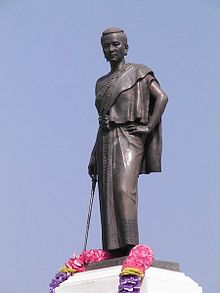Thao Suranari
Thao Suranari ( Thai : ท้าว สุร นารี , pronunciation: [táːw sùʔráʔnaːriː] ; * 1772 ; † 1852 ) was the wife of the governor of Nakhon Ratchasima (Korat). According to a widespread representation in Thailand, it is said to have made a decisive contribution to the suppression of the uprising of the Lao King Anuvong in 1826. In Korat she is revered as a local heroine.
Life
At the age of 25 she married the governor (or fortress commander) of Korat. Her actual name was Khun Ying Mo. The prefix Khun Ying is an honorary title given by the king. The name Thao Suranari ("Brave Lady") was later given to her by King Rama III to honor her participation in the suppression of the Lao uprising . awarded.
Legend
When the tributary King Anuvong of Vientiane and his troops conquered the city in 1826 and imprisoned the soldiers of the fortress, Thao Suranari is said to have held a drinking bout with other women outside the city and then attacked the drunken soldiers. After a month the Laotians could be expelled. ( See also the story of Wat Benchamabophit )
Adoration
Thao Suranari was only briefly and vaguely mentioned in historical records until the 1930s. 1932 under, a group of military and intellectual, which is " People's " (Khana Ratsadon) named, a coup , which ended the absolute monarchy. The new rulers wanted to modernize and democratize the country. They sought to upgrade the role of commoners and women in historiography. The story of the Thao Suranari was embellished and popularized by the nationalist writer and ideologist Wichitwathakan . The sculptor Silpa Bhirasri (actually Corrado Ferroci ), who was born in Italy and associated with the regime, was commissioned to create a statue. It has stood in front of the old city gate ( Pratu Chumphon - ประตู ชุมพล ) of Korat since January 5, 1934 . The monument is 1.85 m high without a base.
Thao Suranari is venerated like a saint by the people of Korat as Ya Mo ( „โม ," Grandmother Mo "). A ten-day festival, the “Thao Suranari Fair”, is celebrated in her honor every year at the end of March / beginning of April.
criticism
On the part of Laotian historians, there have long been doubts about the historical accuracy of the representation of the role of the Thao Suranari, which is widespread in Thailand. In 1995, however, a Thai history student at Thammasat University , Saipin Kaewngamprasert, wrote her master’s thesis entitled The Images of Thao Suranaree in Thai History (later published as a book under the title The Politics of the Thao Suranari Monument ). In it she dealt critically with the heroization of the figure.
According to her portrayal, the nationalist ideologues of the 1930s turned a mere local heroine into a national cult figure. The historically insignificant figure was selected and glorified for political reasons. According to Saipin, the political requirements after the “People's Party” came to power and the suppression of the royalist Boworadet rebellion in October 1934 shaped the historical account of Thao Suranari's role in the suppression of the Lao uprising of Jao Anouvong in 1826. The political calculation behind the erection of the monument and the promotion of the Suranari cult was to ensure the loyalty of the people of Korat.
Thai nationalists and Korat citizens who worshiped Thao Suranari reacted angrily. Many were misinformed and believed that Saipin claimed that Thao Suranari never lived. In March 1996 a protest march of 50,000 people took place in Korat. Ultimately, the book was banned in Thailand.
In 2001, the Thai filmmaker Pisan Akaraseni planned a period drama about the history of the Thao Suranari. There was considerable protest from the Laotian side. There it was claimed that the story was invented for political purposes only. The project was ultimately canceled.
further reading
- Charles F. Keyes: National Heroine or Local Spirit? The Struggle over Memory in the Case of Thao Suranari of Nakhon Ratchasima. In: Cultural Crisis and Social Memory. Modernity and Identity in Thailand and Laos. University of Hawai'i Press, Honolulu 2002, ISBN 978-0-8248-2603-1 , pp. 113-136.
Individual evidence
- ^ " Chang Noi ": Bad neighbors, woman warriors, and paddles. In: The Nation , July 9, 2001.
- ↑ a b Thak Chaloemtiarana: Move Over, Madonna. Luang Wichit Wathakan's Huang Rak Haew Luk. In: Southeast Asia Over Three Generations. Essays Presented to Benedict R. O'G. Anderson. Cornell Southeast Asia Program, 2003, p. 149.
- ↑ Chris Baker , Pasuk Phongpaichit: A History of Thailand. 2nd Edition. Cambridge University Press, 2009, ISBN 978-0-521-76768-2 , p. 297.
- ↑ a b David Streckfuss: Truth on Trial in Thailand. Defamation, treason, and lèse-majesté. Routledge, 2011, p. 397.
- ↑ Thak Chaloemtiarana: Thailand. The Politics of Despotic Paternalism. Cornell Southeast Asia Program, Ithaca NY 2007, ISBN 978-0-8772-7742-2 , p. 249.
- ^ A b Oliver Tappe: History, nation building and legitimation politics in Laos. Lit Verlag, 2008, p. 133.
- ^ Grant Evans, Different Paths. Lao Historiography in Historical Perspective. In: Contesting Visions of the Lao Past. Lao Historiography at the Crossroads. NIAS Press, 2003, pp. 104-105.
- ↑ Ronald Bruce St John: Revolution, Reform and Regionalism in Southeast Asia. Cambodia, Laos and Vietnam. Routledge, 2006, p. 167.
| personal data | |
|---|---|
| SURNAME | Thao Suranari |
| BRIEF DESCRIPTION | Wife of the governor of Nakhon Ratchasima |
| DATE OF BIRTH | 1772 |
| DATE OF DEATH | 1852 |


